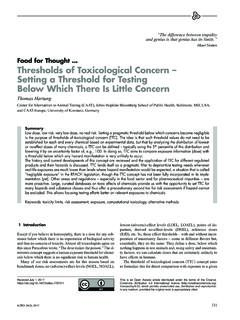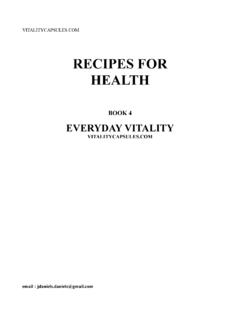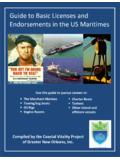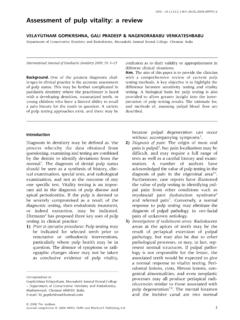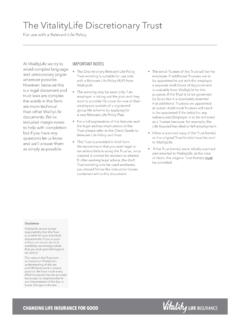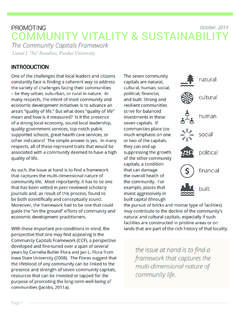Transcription of Poloxamer 188 Supplemented Culture Medium Increases the ...
1 Altex 27, 3/10191 Poloxamer 188 Supplemented Culture Medium Increases the vitality of Caco-2 Cells after Subcultivation and Freeze/Thaw CyclesVera Kerleta 1, Isabella Andrlik 1, Susanne Braunm ller 2, Thomas Franke 2, Michael Wirth 1 and Franz Gabor 11 Department of Pharmaceutical technology and Biopharmaceutics, University of Vienna, Austria; 2 experimentalphysik I, University of Augsburg, Germany1 IntroductionIn order to reduce animal trials during preclinical evaluation of APIs (active pharmaceutical ingredient) as well as to circum-vent clinical verification of the bioequivalence of certain for-mulations, the biopharmaceutics classification system (BCS) is recommended by the FDA (Food and Drug Administration) as well as the eMeA (european Medicines Agency) (Kim et al., 2006). The monolayer-forming Caco-2 cell line is an integral part of this biowaiver to assess the permeability of APIs across artificial human intestinal epithelium by mimicking the process of absorption (Artursson et al.)
2 , 2001). the accuracy of predict-ing human absorption is about 60% (Sachan et al., 2009).the reproducibility and reliability of such assays strongly de-pend on the viability of the cells. Routine cultivation, however, requires procedures which are unfavourable to live cells: Sub-cultivation of cells might harm or damage the cell membrane in the course of the proteolytic detachment of adherent cells. even mild manipulation of cells might be injurious because of exposition to shear forces during pipetting. Cryostorage of cells comprises freezing and formation of ice crystals inside and out-side the cell, which may disrupt cell membranes. In turn, re-crystallisation during thawing can also be detrimental for cell survival (Woods et al., 2004). to overcome these problems and to improve the relevance of cell models, the media that are cur-rently used must be terms of cryostorage, all BAlB/c myeloma cells stored in Medium containing 1% Poloxamer 188 survived freezing/thawing as compared to 80% without a supplement (Gonz les Hern ndez and Fischer, 2007).
3 Meanwhile, this cryomedium is commercially available (Filoceth -media, procryotect GmbH, Ruedlingen, Switzerland), and it was suggested that the sur-factant acts by stabilising the cell 188 (Pluronic F-68, PF-68) is a non-ionic sur-factant with an average molecular weight of 8400 Da and is composed of eO (polyoxyethylene) and PO (polyoxypropyl-ene) units arranged in a basic triblock structure according to eO76-PO30-eO76. the non-toxic surfactant is approved by the FDA for oral and parenteral application in concentrations rang-ing from ( , ). It has been reported to exert cytoprotective effects, higher viability of mammalian cells under high agitation (Al-Rubeai et al., 1993), and multiple pro-tective effects on tetrahymena cells exposed to various physical and/or chemical stress parameters (Hellung-larsen et al., 2000). the cytoprotective effects were explained by a complex interac-tion between the cell membrane and Poloxamer 188 (Al-Rubeai SummaryCryostorage media containing 1% of the non-ionic surfactant Poloxamer 188 provided full recovery of mammalian cells (Gonz lez Hern ndez, 2006), but its effects during thawing of cryostored cells and proteo-lytic subcultivation are still unknown.)
4 In this study, the proliferation and viability of pre-confluent Caco-2 monolayers cultivated in media Supplemented with the non-ionic surfactant were investigated. The addition of Poloxamer 188 increased proliferation of subcultivated cells fold and that of thawed cells about twofold. According to microaspiration experiments the non-ionic surfactant increased the tension of the cell membrane most notably at concentrations owing to adsorption and incorporation into the phospholipid bilayer. Thus, the performance of the cells appears to be improved. Since vitality of cells is a prerequisite for reproducibility and reliability of cell models for absorption studies at early stages of drug development, use of Poloxamer 188 Supplemented cultivation media may help to refine cell culturing to further reduce animal trials in preclinical : Poloxamer 188, Caco-2 cells, proliferation, cell membrane undulation, micropipette aspirationReceived 17th February 2010, received in revised form and accepted for publication 20th May 2010 Ke r l e t a e t a 27, 3/10192reader, tecan, Gr dig, Austria) at 450 nm.
5 The tests were per-formed at least in triplicate with 6 wells in viability of cells was analysed using the eZ4U test (easy for you, Biomedica, Vienna, Austria) following the manufactur-er s instructions. Briefly, the split cells were seeded in 96-well microplates at a density of 3000 cells/well in 200 l Medium as above and cultivated for 3 days in a humidified atmosphere with 5% CO2 at 37 C. The tetrazolium salt is reduced by the mitochondria of viable cells to yield water soluble orange col-oured formazan, which is quantified at 450 nm. The tests were performed at least in triplicate with 6 wells in membrane tension determinationThe micropipette aspiration technique was applied to determine the stiffness of the cell membrane (Hochmuth, 2000). Micro-pipettes were pulled from borosilicate glass, filled with PBS, mounted on a syringe and connected with a fluid reservoir. 50 l of the cell suspension, containing x 105 cells in Culture Medium , was incubated with 50 l 0%, 1% or 5% Poloxamer 188 in 20mM isotonic HEPES/NaOH, pH , for 60 minutes at 37 C.
6 Under microscopic inspection using a Zeiss Axiovert 200 microscope (Zeiss, Munich, Germany) equipped with a 40x objective and a Hamamatsu camera (Hersching, Germany), the micropipette was moved to touch a cell and a distinct negative pressure was applied to fix the cell at the orifice. The apex of the cell membrane was set as the zero-point for evaluation of the membrane extension. Equal steps of -100 Pa were applied until the cell membrane stopped each pressure change an image was acquired and the posi-tion of the apex of the aspirated cell was calculated. these data were fit into equations 1 and 2 to calculate strain and tension (evans and Rawicz, 1990). the length deformation of an object caused by stretching or compression is called areal strain ( A) . It has no dimension and can be calculated from:The tension ( ) of the membrane represents the force against the suction pressure and can be expressed as:P = suction pressureRp = inner diameter of the pipetteRc = diameter of the cell L = length were exported to the GraphPad Prism statistics software package (GraphPad Prism Software, USA).
7 Statistics were per-formed using one-way ANOVA with post-hoc Dunnett s tests, comparing the study groups to untreated controls (95% confi-dence interval). P-values < were considered al., 1993). However, sometimes contradictory findings were reported in terms of the tension of the cell membrane (togo et al., 1999; Zhang et al., 1992).the aim of this work was to elucidate some additional advan-tageous effects of Poloxamer 188 Supplemented media on sub-cultivated and thawed cells after cryostorage using proliferation and viability as indicative parameters for cytoprotection. Fur-thermore, to shed some light on the mechanisms of cytoprotec-tion as well as to confirm the explanation of the cryoprotective effects of Poloxamer 188 cell membrane tension measurements were Materials and methodsChemicalsPoloxamer 188 was obtained from Sigma-Aldrich Chemie Gm-bH (Vienna, Austria). All other chemicals in use were of analyti-cal Culture techniquesCaco-2 cells were obtained from DSMZ (Deutsche Sammlung von Mikroorganismen und Zellkulturen GmbH, Braunschweig, Germany).
8 The cells were grown in RPMI 1640 (Rosewell Park Memorial Institute) cell Culture Medium containing 10% foe-tal bovine serum (FBS), 4 mmol L-glutamine and 150 g/ml gentamycine in a humidified atmosphere with 5% CO2 at 37 C. Upon reaching ~80-90% confluence the cells were subcultured with tryple Select and seeded for the proliferation and vi-ability cryopreservation x 106 cells were suspended in 1 ml cryo- Medium (RPMI- Medium Supplemented as above with ad-ditionally 10% FBS and 10% DMSO (dimethyl sulphoxide)). After equilibration in a Nalgene Mr Frosty Cryobox (Thermo Fisher Scientific, Roskilde, Denmark) for 25 min at -20 C the cryovials were stored at -80 C for at least one week. For thaw-ing, the cryovials were warmed up as fast as possible in water at 37 C. Then, the cell suspension was transferred into 10 ml cell Culture Medium at 37 C, spun down (1000 rpm, 4 C, 5 min) and the supernatant containing cytotoxic DMSO was discarded.
9 After resuspension in fresh cell Culture Medium the cells were seeded for proliferation and viability and viability teststhe proliferative activity of the cells was determined using the BrdU cell proliferation ELISA test kit (Roche Diagnostics Gm-bH, Vienna, Austria) according to the manufacturer s instruc-tions. Immediately after splitting or thawing the cells were seed-ed in a 96-well microplate (Iwaki, Bertoni, Vienna, Austria) at a density of 8 x 103 cells in 200 l Medium per well and cultivated for 2 or 3 days under cell Culture conditions. the Medium con-sisted of 20 l sterile-filtered ( m pore diameter) surfactant solution in 20 mM isotonic HEPES/NaOH buffer, pH , or buffer alone and 180 l cell Culture Medium , resulting in 0, , , , or Poloxamer 188 content. the incorporation of 5-brom-2-desoxyuridine (BrdU) into the DNA of proliferat-ing cells was quantified using a microplate reader (Spectrafluor-Ke r l e t a e t a 27, 3 fold and Poloxamer 188 increased it fold in com-parison to the control.)
10 After cultivation for three days this effect was even more pronounced, ranging from a fold increase at surfactant to a enhancement at Poloxamer 188 as compared to cultivation without order to assess possible toxic effects of Poloxamer 188, the viability of Caco-2 cells was tested after 3 days of cultivation (t ab. 1). the cells viability was indicated by their mitochondrial activity in reduction of tetrazolium salt to orange coloured forma-zan. As compared to cultivation without surfactant, the presence of Poloxamer 188 increased the viability of the same number of cells by about 70% in the range of and still 42% at thus, Poloxamer 188 not only proved to be non-toxic within this period, but it even improved the cells Membrane aspiration testto elucidate the effect of Poloxamer 188 on the physical char-acteristics of Caco-2 cells, membrane aspiration tests were per-formed with cells preincubated with Culture Medium containing 0%, or surfactant.

